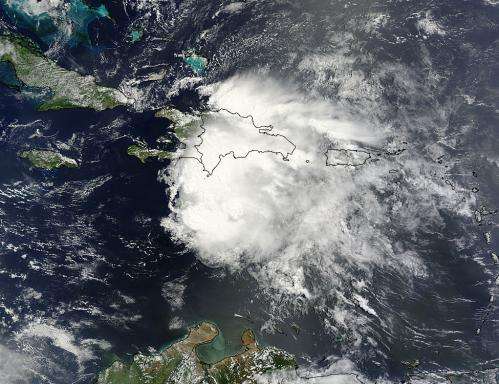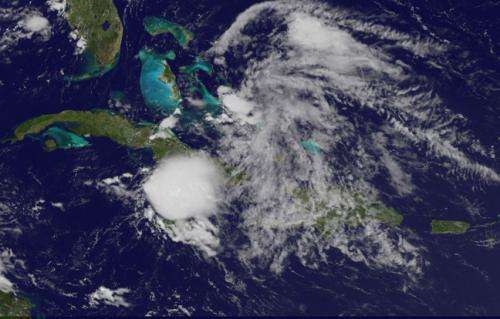NASA sees Chantal weaken to a remnant

Tropical Storm Chantal moved over Hispaniola on July 10 when NASA's Terra satellite passed overhead from space, and less than twenty-four hours later the storm weakened to a remnant low pressure area.
The Moderate Resolution Imaging Spectroradiometer or MODIS instrument that flies aboard NASA's Terra satellite captured a visible image of Chantal when it was a tropical storm over Hispaniola on July 10 at 15:20 UTC (11:20 a.m. EDT). At that time, Chantal's northern quadrant covered the Dominican Republic and eastern Haiti while the center of the storm remained south of Hispaniola.
Tropical Storm Chantal ran into some strong upper-level winds that tore the storm apart. The National Hurricane Center (NHC) issued the final bulletin on Chantal on July 10 at 2100 UTC (5 p.m. EDT). At that time it was considered a remnant low pressure area with maximum sustained winds near 40 knots. Tropical-storm-force winds were occurring over a large area south of Hispaniola. It was centered near 16.5 north latitude and 73.7 west longitude, about 230 miles east-southeast of Kingston, Jamaica and moving to the west at 25 knots. All warnings were cancelled.
NHC noted that Chantal was no longer considered a tropical cyclone and that its remnants would bring rainfall totals between 3 and 6 inches to Hispaniola, Jamaica, central and eastern Cuba as well as the southeastern Bahamas.
On July 11, the remnant low and its associated showers and thunderstorms stretched from Hispaniola northward to the southeastern and central Bahamas and the adjacent Atlantic waters. Some heavy rains and gusty winds were expected to spread over the southeastern and central Bahamas today, July 11, and Friday, July 12, according to NHC.

NOAA's GOES-13 satellite has been capturing images of Chantal's demise. NASA's GOES Project at the NASA Goddard Space Flight Center in Greenbelt, Md. created an image on July 11 at 1445 UTC (10:45 a.m. EDT) that showed showers and thunderstorms associated with the low stretched from Hispaniola north into the Bahamas. There was also another area of thunderstorms over eastern Cuba.
Because the upper-level winds are still strong, the NHC noted that there are no signs of regeneration and the forecast calls for the winds to remain hostile for significant development. So, NHC has given Chantal's remnants just a 20 percent of becoming a tropical cyclone again over the next 48 hours.
Provided by NASA's Goddard Space Flight Center





















